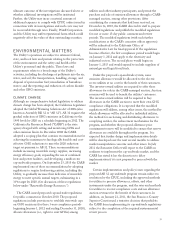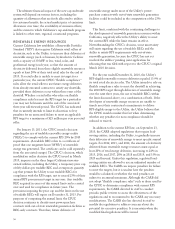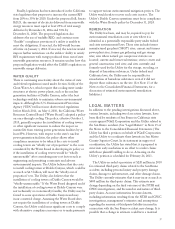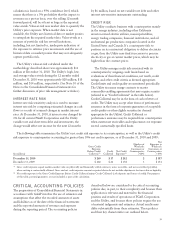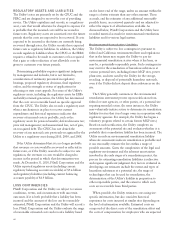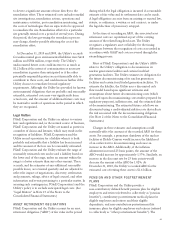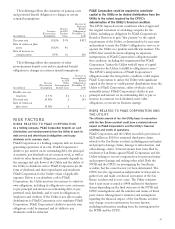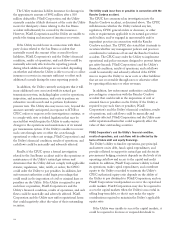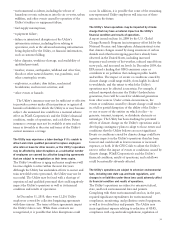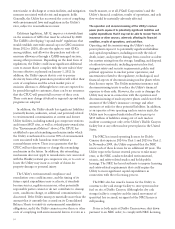PG&E 2010 Annual Report Download - page 49
Download and view the complete annual report
Please find page 49 of the 2010 PG&E annual report below. You can navigate through the pages in the report by either clicking on the pages listed below, or by using the keyword search tool below to find specific information within the annual report.PG&E Corporation. PG&E Corporation also would need
to consider its alternatives, such as contributing capital to
the Utility, to enable the Utility to fulfill its obligation to
serve. If PG&E Corporation is required to contribute
equity to the Utility in these circumstances, it would be
required to secure these funds from the capital or credit
markets.
PG&E Corporation’s and the Utility’s ability to access
the capital and credit markets, and the costs and terms of
available financing, depend on many factors, including
changes in their credit ratings, changes in the federal or
state regulatory environment affecting energy companies,
the overall health of the energy industry, volatility in
electricity or natural gas prices, and general economic and
market conditions.
Market performance orchanges inotherassumptions could
require PG&E Corporationand the Utility to make significant
unplanned contributions to its pensionplan, other
postretirementbenefits plans, andnucleardecommissioning
trusts.
PG&E Corporation and the Utility provide defined benefit
pension plans and other postretirement benefits for eligible
employees and retirees. The Utility also maintains three
trusts for the purposes of providing funds to decommission
its nuclear facilities. Up to approximately 60% of the plan
assets and trust assets have generally been invested in
equity securities, which are subject to market fluctuation. A
decline in the market value may increase the funding
requirements for these plans and trusts.
The cost of providing pension and other postretirement
benefits is also affected by other factors, including the
assumed rate of return on plan assets, employee
demographics, discount rates used in determining future
benefit obligations, rates of increase in health care costs,
levels of assumed interest rates, future government
regulation, and prior contributions to the plans. Similarly,
funding requirements for the nuclear decommissioning
trusts are affected by changes in the laws or regulations
regarding nuclear decommissioning or decommissioning
funding requirements, changes in assumptions as to
decommissioning dates, technology and costs of labor,
materials and equipment change, and assumed rate of
return on plan assets. For example, changes in interest rates
affect the liabilities under the plans: as interest rates
decrease, the liabilities increase, potentially increasing the
funding requirements.
The Utility recovers forecasted costs to fund pension
and postretirement plan contributions and nuclear
decommissioning through rates. If the Utility is required to
make significant unplanned contributions to fund the
pension and postretirement plans and nuclear
decommissioning trusts, and is unable to recover such
contributions in rates, the contributions would negatively
affect PG&E Corporation’s and the Utility’s financial
condition, results of operations, and cash flows.
Other Utility obligations, such as its workers’
compensation obligations, are not separately earmarked for
recovery through rates. Therefore, increases in the Utility’s
workers’ compensation liabilities and other unfunded
liabilities caused by a decrease in the applicable discount
rate negatively impact net income.
The Utility’s ability to recoverits costs may be impacted by the
economy and the economy’s corresponding impact onthe
Utility’s customers.
The Utility is impacted by the economic cycle of the
customers it serves. For example, during the last economic
decline in the Utility’s service territory, customer growth
slowed and customer demand decreased. Increased
unemployment and a decline in the values of residential
real estate resulted in an increase in unpaid customer
accounts receivable. A sustained downturn or sluggishness
in the economy also could reduce the Utility’s sales to
industrial and commercial customers. Although the Utility
generally recovers its costs through rates, regardless of sales
volume, rate pressures increase when the costs are borne by
a smaller sales base.
The completionof capital investmentprojects is subject to
substantial risks, and the rate at which the Utility invests and
recovers capital will directly affect net income.
The Utility’s ability to develop new generation facilities
and to invest in its electric and gas systems is subject to
many risks, including risks related to obtaining regulatory
approval for capital investment projects, securing adequate
and reasonably priced financing, obtaining and complying
with the terms of permits, meeting construction budgets
and schedules, and satisfying operating and environmental
performance standards. Third-party contractors on which
the Utility depends to develop these projects also face
many of these risks. Changes in tax laws or policies, such as
those relating to production and investment tax credits for
renewable energy projects, may also affect when or whether
the Utility develops a potential project. The development
of proposed Utility-owned renewable energy projects may
also be affected by the extent to which necessary electric
transmission facilities are built and evolving federal and
state policies regarding the development of a “smart”
electric transmission grid. In addition, reduced forecasted
demand for electricity and natural gas as a result of an
economic slow-down may also increase the risk that
projects are deferred, abandoned, or cancelled.
45


